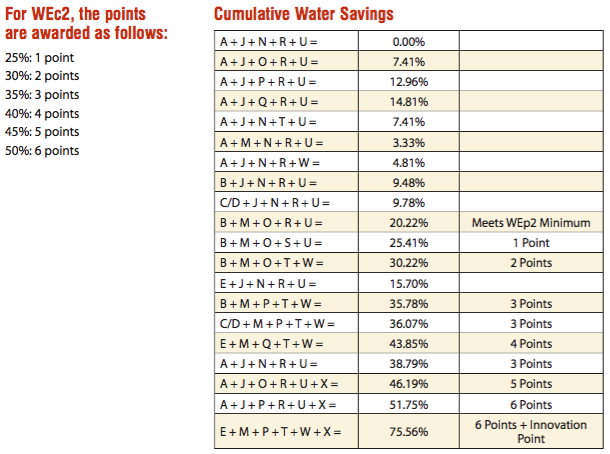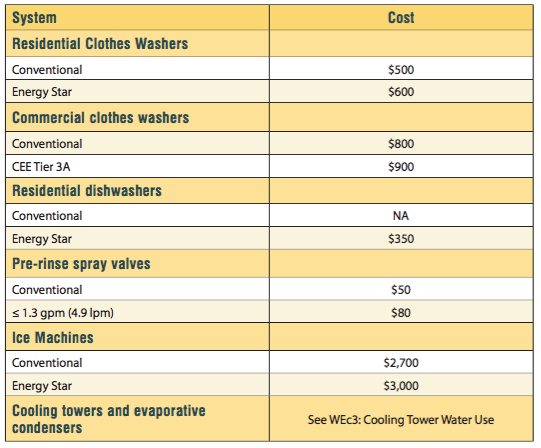Yesterday’s water-saving strategies are increasingly today’s codes. LEED v4 teams will need to dig deeper for water savings, potentially with added cost premiums. However, water savings, in addition to being common sense in response to water stresses in various locations, often have favorable payback periods.
Notes on Rainwater Capture
The reclaimed rainwater/graywater calculation is based on a 35,000 ft2 roof in the Boston, Massachusetts area (42” annual precipitation) and capturing 50% of the total precipitation over the course of the year, for a total of 458,150 gal/yr.
Water quantity captured will vary based on building location, roof size and capture percentage. When figuring capture percentage, remember that there will be times that the tank is already full when it is raining and the tank cannot hold more water. There may also be dry periods when it needs potable water make-up. The calculation assumes a three-story office building with 700 occupants, 350 Men and 350 Women, with urinals in all men’s rooms, sinks at coffee stations and kitchenettes, and employee showers at changing rooms.
Although rainwater capture and reuse is very feasible, many jurisdictions will require projects to install treatment systems and separate piping same as is required for graywater. However, rainwater has some advantages: it does not require as much treatment as graywater, nor does it have the odor issue. Local authorities may require metering, especially if sewer charges are based on water consumption.
Municipalities are increasing requirements for onsite stormwater management, contributing to cost synergies and reduced LEED cost premium. We have completed projects using reclaimed stormwater where the tank was actually required by local authorities mandating that the project install stormwater detention in order to prevent the building from overwhelming the already stressed storm drainage infrastructure. Once the tank was required, the LEED premium becomes simply the pump, filtration, and separate water piping.
Note that reclaimed water is only considered under WEc2. Prerequisite compliance is based on fixtures only.
Notes on the Cumulative Water Savings Calculation
The cumulative water savings table shows the water savings in percent as calculated by the LEED Online template calculator for a few combinations of fixtures. It assumes one selection of each type of plumbing fixture from the table above. LEED water calculations are based on the occupancy count (actual or default) in the building, and not on the number of plumbing fixtures.
While it is beyond the scope of this study to calculate the water savings for each and every combination of the fixtures listed, we have included some standard combinations so the reader can see how changing the fixture affects the water savings.
The first few combinations use standard 1.6 GPF toilets and baseline 0.5 GPM lavatory faucets, and show the savings gained by changing the sink and showerhead flows. Only when the toilet is changed to 1.28 GPF, and the lavatory faucets are reduced to 0.35 GPM along with reducing the urinal to 0.5 GPF can we see savings that can meet the minimum for the prerequisite in WEp2.
By additionally reducing the showerhead to 1.8 GPM, we see savings that can achieve one point in LEED v4. By incrementally reducing the showerhead and kitchen sink to 1.5 GPM, we see two points are achieved. A third point is achieved by further reducing the urinal flow to 0.125 GPF (pint-per-flush). Changing to a dual flush 0.8 / 1.6 GPF toilet and a waterless urinal will achieve four points.
That’s the limit of savings and points awarded for projects that only use standard fixtures; in order to get higher savings, a project will need to consider composting toilets or reclaimed or reused stormwater or graywater.
Note that commercial buildings must use 0.5 GPM flow faucets as a baseline. Residential projects may use a 2.2 GPM faucet as a baseline. The residential option was not included in our cumulative cost savings table; those projects could see greater savings than are shown there.
Process Water
LEED v4 incorporates water use from appliances and interior processes, including laundry, dishwashing, and HVAC systems. Residential projects should consider the use
of Energy Star rated dishwashers and clothes washers. Commercial projects must weigh the impact of energy saved by using evaporative cooling or condensing, versus the cost of water used, treatment systems and chemicals, and sewage costs (treated water should be discharged to sanitary systems, not to stormwater systems or direct to groundwater recharge).
Cost Synergies
LTc6: Bicycle Facilities (showers)
SSc4: Rainwater Management
EAp2/EAc2: Minimum/Optimize Energy Performance


